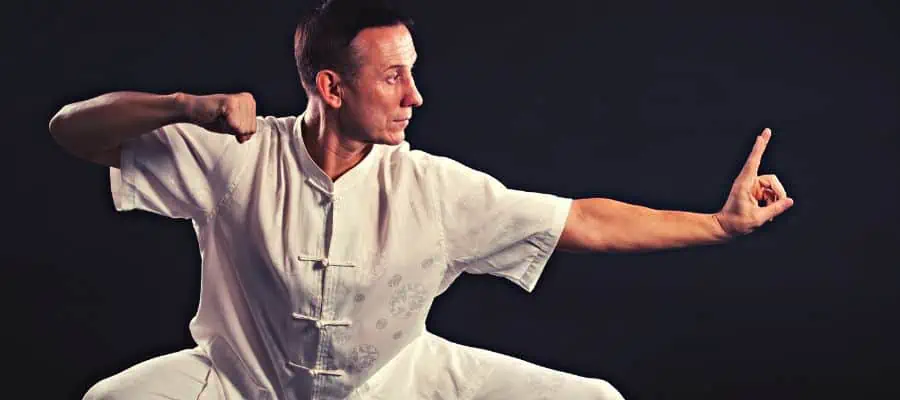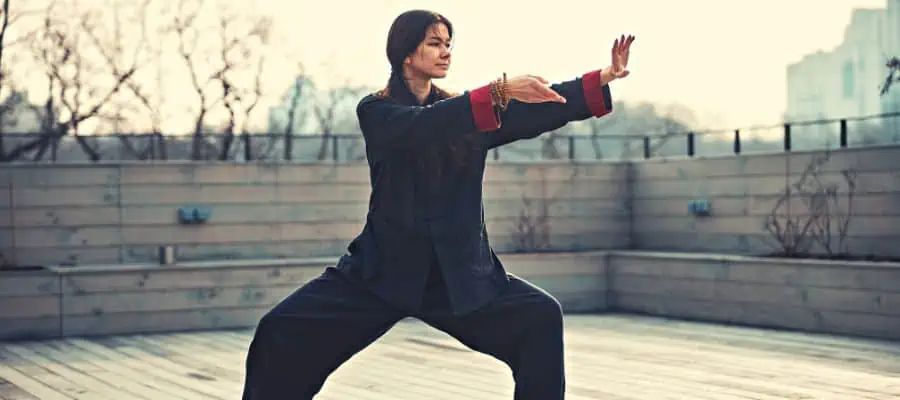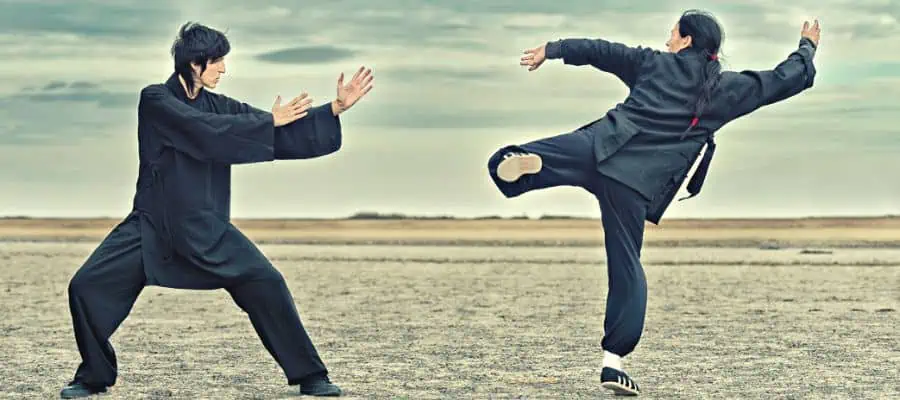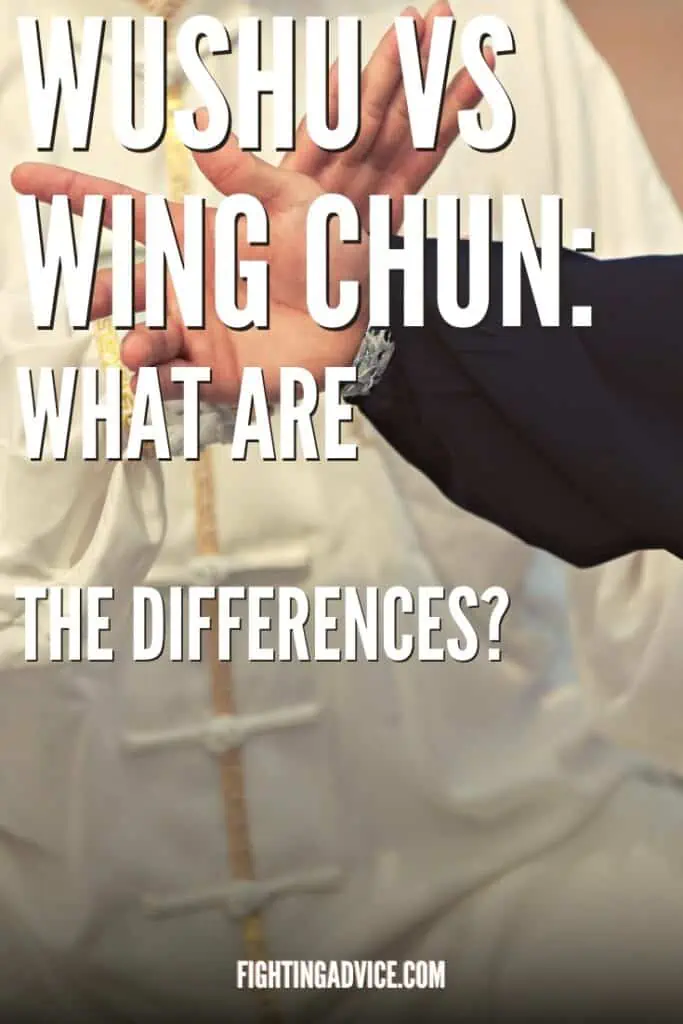Far East Asian countries are the motherland of many martial arts. Some of them are hundreds of years old. The skills have been passed down and developed over many years, and today they are spread worldwide. Kung Fu is only one of those arts and has many styles; the oldest forms are Wushu and Wing Chun.
So, what is the difference between Wushu and Wing Chun? Wushu is a combat sport characterized by a wide variety of combat movements. Dissimilar to Wing Chun, a martial art that functions in a completely different combat plan with the most straightforward and efficient techniques.
The things these skills have in common are the country of origin and the fact that they are both kung fu styles with the primary goal of self-defense. After years of evolution of these arts, their practices and principles diverged in many ways.
| Wushu | Wing Chun | |
|---|---|---|
| What It Is | Wushu is a style of kung fu. It is a full contact Combat sport. | Wing Chun is a style of Kung Fu. It is a martial art for close-quarter self-defense. |
| Origins | Greater China Bronze Age (3000-1200 BC). Officially became a sport in 1990. | Southern China, Foshan The rule of the Qing Dynasty (1644-1912) |
| Focused On | Kicks, punches, takedowns, throws, sweeps, and submissions. Basic offensive and defensive movements bare-handed or with weapons. | Timing, positioning, relaxed movement, balance, mental concentration, simplicity, and explosive movements with the quick generation of force. |
| Popular Styles | Taolu (Set of choreographed routines) Sanda (Full-contact Sparring) | Si Lum Tao “Little Imagination” Chum Kil “Bridge-Seeking” Bil Jee “Thrusting Fingers” |
| Strengths | Sanda, due to its admixture of effective striking and offensive and defensive wrestling with submissions, prepares you for a real-life combat scenario. | Due to its simple and effective structure that minimizes the use of brute force, Wing Chun enables quick finishing of opponents. |
| Weaknesses | Taolu, due to the impossibility of transferring choreographic routines in real-life combat situations. | Shortening the distance because the Wing Chun mode is only effective at close range. |
| Viability in a Street Fight | Sanda is effective in a real fight and for self-defense. It can be used against multiple attackers. Taolu is not effective. | If trained well, Wing Chun is effective for self-defense. With favorable use of space and crowds, it can be effective against multiple attackers. |
| Physical and Mental Benefits | Taolu is good for building the acrobatic abilities of the body. Sanda is good for getting the body into a fit and fighting shape. | Wing Chun emphasizes calmness, awareness, good reflexes, and physical and mental relaxation. It enables a full-body workout, helps to lose weight, and increases endurance and muscle efficiency. |
Differences Between Wushu and Wing Chun

One big difference is that Wushu is a competitive sport, unlike Wing Chun, which has one key goal, which is the practice of self-defense only. However, getting to know both skills severally and comparing them is the best way to see how they differ.
What is Wushu?
Wushu means “martial art” and is better known as Kung Fu. It is a system of fighting techniques that include free sparring and routine exercises, the main goal of which is to strengthen the body and will, improve fighting skills, and promote health. Wushu is sundered into two types, namely Taolu and Sanda.
History of Wushu
The history of Wushu stretches back thousands of years to the Bronze Age. It arose as a need for self-defense against the harsh and hostile conditions in which people lived then. The country of its origin is China because it was created from several Chinese martial arts.
In 1990, it officially became a sport when the International Wushu Federation was founded to bring different martial arts under one structure. Although it is still not an Olympic-recognized sport, Wushu holds its competitions at the world level, such as the Mediterranean Games, the World Wushu Championships, and the Asian Games. Since it is spread all over China, it has gone through a thousand years of development due to different principles, philosophies, techniques, and tactics.
Taolu Wushu (Forms)
Taolu routine comprises a continuously connected set of pre-determined techniques choreographed according to certain principles and philosophies to incorporate stylistic principles of attack and defense. It is similar to gymnastics because it is performed in choreographed routines.
Taolu includes work with hand and foot techniques, sweeps, jumps, throws, footwork, and balance. Taolu routines embrace group and individual patterns, and their wide range of content includes weapons and bare-handed techniques.
The training aims to develop motor skills such as speed, stamina, strength, balance, flexibility, and coordination in the practitioner. In Taolo, 11 competitive events are used under the guidance of the International Wushu Federation, and these events are divided into basic categories.
Short Weaponary Events
- Daoshu (Broadsword)
- Jianshu (Straight sword)
- Nandao (Southern Broadsword)
- Taijijian (Tai Chi Straight Sword)
Long Weaponary Events
- Gunshu (Cudel)
- Qiangshu (Spear)
- Nangun (Southern Cudgel)
Barehand Events
- Chang Quan (Northern Long Fist)
- Nan Quan (Southern Fist)
- Taiji Quan (Tai Chi)
Also, the eleventh competitive event includes Duilian, which is choreographed sparring or duel. It is an event where previously trained sparring choreography is practiced, which can be:
- Bare hands against weapons
- Weapons against weapons
- Bare hands against bare hands
Wushu Sanda (Sparring)
Sanda is a competitive Wushu event that includes full-contact sparring. It is a modern martial method focused on self-defense and martial sport combat without weapons. Similar to kickboxing, which also covers grappling segments.
It features Chinese boxing, kicks, throws, takedowns, sweeps, offensive and defensive wrestling, and submissions. It was created by the Chinese Elite Forces and military to develop realistic and applicable fighting methods. Because of this, Sanda practitioners can participate in other competitions in world martial arts and be effective in that field. The Chinese claim that it consists of basic fighting techniques that can be split into four groups:
- Da (implies striking the lower part of the body)
- Ti (implies striking the lower part of the body)
- Shuai (implies wrestling, judo throws, sweeps, and takedowns)
- Chi-Na (includes various submission locks and chokes)
Sanda’s rules include using protective equipment, such as groin protection, chest protector, mouthguard, protective helmet, shinguards, and boxing-like gloves. There are two types of scoring: Stand up scoring and takedown scoring.
Therefore, scoring includes legal blows to the head, torso, tights, knockdowns, and successful takedowns. On the other hand, hitting the back of the head, between the legs, and the neck is prohibited. Elbows, knees, and head strikes are also prohibited, as well as hitting the opponent while he is on the ground.
The fight takes place in three rounds of two minutes each with one minute rest. If one competitor wins the first two rounds, the match is stopped, and he is declared the winner.
What is Wing Chun?
Wing Chun is one of the earliest styles of Kung Fu. However, it differs from other styles because its structure focuses on natural and scientifically proven movements and force generation in the most efficient way possible. It is known for eliminating any unnecessary maneuvers
It is a self-defense martial art functional in close contact with no rules or limitations. It includes kicks, punches, throws, and submissions. The goal of Wing Chu is to eliminate the opponent as quickly and successfully as possible.
History of Wing Chun
Wing Chun is an ancient art from Southern China. It is considered one of the three most significant martial arts in that area. It begins with a Buddhist nun from the Shaolin Temple, Ng Mui, during the Qing Dynasty.
Her goal was to develop a new skill that would work on the principle of using proper technique rather than brute force, which enables a more clever approach to physical confrontation. Wing Chun can also be expressed as a way for a smaller person to overcome a larger aggressor.
The birth of this principle happened because of many confrontations of Ng Mui with much stronger male opponents and sometimes armed ones. Although its history is full of legends, folklore, and transmission of unwritten stories, it was only in the 19th century that the first records on this topic were written by Leung Jan.
He was a Wing Chun practitioner and martial artist from Heshan. Leung managed to translate his teacher’s generational knowledge into written records. In 1970, Wing Chun became known to an audience outside of Asia through the legendary Bruce Lee.
Principles of Wing Chun Effectiveness
The structure of Wing Chun consists of several principles, the improvement of which through training makes the possibility of self-defense effective in close combat. Practitioners practice closing the distance to the opponent and exploiting their balance and structure against them.
- Body posture, central line, and balance.
In theory, the person with the better body posture emerges as the winner, which makes this the first and most important principle of this martial art. A firm and grounded but flexible and mobile body posture is required. Part of the training is based on balance practice because with good balance comes the ability to maintain the structure during an attack or to quickly recover it if it is endangered.
Also, a proper stance gives the ability to generate the necessary force as swiftly and as well as possible. Hands must be in the central line where they protect the most sensitive points of the body. That main line is a measure of the distance from chest to chest, and at the end of this line are the opponent’s vulnerable points, such as the eyes, nose, throat, solar plexus, and genitals. Footwork is used to shorten that distance.
- Physical relaxation and mental concentration
For the beforementioned balance to be centered and the body posture to stay ready for attack and defense, it is necessary to get rid of tension in the head and body. Excessive muscle contraction reduces the speed and strength of the blow, reduces the speed of movement, and creates stiffness that the opponent can use to his advantage.
Because of this, Wing Chun requires maximum mental presence at the moment of the fight, and to be present; we must be completely relaxed. Relaxation gives fluidity to the body and the ability to produce effortless power. All of the above makes Wing Chun a good discipline for training the unification of the body’s mental and physical potential.
- Practicality and simplicity
Every situation can develop and get complicated in a million ways. Consequently, there is more than one way to solve it. Because of this, it is best to do it in the simplest way possible to solve it efficiently. One must train multiple diverse, realistic, and simple techniques.
The simplicity of movements and strikes is one of the main characteristics of Wing Chun. The foundations of Wing Chun techniques are developed on the principle of natural body movements, which makes them easy and fast to apply.
Unnecessary and additional body movements have been eliminated to keep the technique short and plain. Maneuvers of a human figure are reduced to the uncomplicated point, and through strenuous and regular movement training, combat technique turns into a reflex.
Also, using the technique is practical because it is not limited to the space you are in and the clothes you wear. Wing Chun’s goal is not to look stunning but to be simple and functional.
Is Kung Fu Effective in a Street Fight?

There is a difference between being able to defend yourself and being able to fight. Kung Fu was originally developed for self-defense, but it depends on the form you practice.
As for Wushu, only one of the styles is effective in the case of a physical confrontation on the street. Taolu is the choreographic part of Wushu, and despite what you’ve seen on stage, it’s not practical for street fighting.
On the other hand, if we skip the performance aspect, we have another style: Sanda. Since Sanda is a full-contact sport with an effective stand-up fight, the ability to take down an opponent and get them in a submission hold makes Sanda a desirable skill to know if you need to fight and defend yourself.
Wing Chun is solid for self-defense if you dedicate to its training for many years. This skill will help you in an unpleasant situation. Wing Chun’s most important benefit is that it enables the incapacitation of the aggressor in the shortest possible time, which reduces the chances that the physical confrontation will take longer. Of course, your chance of defense is equal to your training.
What Are the Benefits of Kung Fu?

The already mentioned kung fu self-defense is just one of the good things. All martial arts are generally benevolent for physical and mental health. If you train regularly, you can always expect to be in fighting and fit physical shape, regardless of the sport in question.
Kung Fu gives a full-body workout. Even the warm-up for this martial sport includes compound workouts. Its benefits are increased stamina, cardiovascular performance, strength, speed, coordination, body balance, and endurance.
Since it has good cardio benefits, it will be useful for those who struggle with excess weight. It is great for stress relief, and its mental training will give you better self-control. Knowing that you can get out of a physically uncomfortable situation will make you less likely to get into one. Kung Fu also builds confidence.
Still, Kung Fu is not only a physical activity, but it is also a proper way to teach you to be calmer and more disciplined, and it will instill in you respect for others.
Conclusion
We can summarize that these two ancient Chinese skills have their qualities and shortcomings. Although both come from Kung Fu, they differ in many ways. Wushu is a competitive kung fu form. It has solid expertise in both self-defense and combat. Practicing Taolu will develop your body the same way as gymnastics. Still, you cannot transfer your knowledge outside of choreographic performances.
With the mastery of Sanda, you can open doors for yourself in many martial arts competitions. Wing Chun is only acceptable for self-defense and quickly incapacitating an opponent. Still, it is not recognized as a sport. Practicing these skills will bring advantages to both your body and your psyche.
One thing is definite, by training in either of these two forms of kung fu, whether it is Sanda or Wing Chun, you increase your chances of being able to defend yourself.
If you found this article useful, you may want to save this pin below to your Combat Sports board.

Recent Posts
Karate is a martial art that uses all body parts for self-defense without using any weapons other than your own body. Karate in Japanese means empty hand. Participants practice hand and foot...
For those with interest in Karate, you may have heard of Goju-Ryu and Kyokushin Karate. They have unique features that distinguish them from each other, which can prove valuable for...
